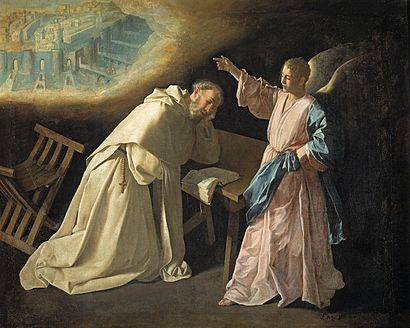The Vision of Saint Peter Nolasco facts for kids
Quick facts for kids The Vision of Saint Peter Nolasco |
|
|---|---|
 |
|
| Artist | Francisco de Zurbarán |
| Year | 1629 |
| Medium | oil on canvas |
| Location | Museo del Prado, Madrid |
The Vision of Saint Peter Nolasco is a famous painting from 1629. It was created by the Spanish artist Francisco de Zurbarán. Today, you can see this artwork at the Museo del Prado in Madrid, Spain.
This painting shows Peter Nolasco having a special dream. Peter Nolasco was a very important person. He founded a religious group called the Mercedarians. He also started an abbey, which is like a monastery, in Seville.
The Mercedarians asked Zurbarán to paint this picture. They wanted it to celebrate Peter Nolasco becoming a saint. This happened in 1628, just one year before the painting was made. Zurbarán also painted another picture that goes with this one. It is called Saint Peter Nolasco's Vision of Saint Peter the Apostle.
The Mercedarians ordered many paintings for this special event. They asked for twenty artworks in total. Only a few of these paintings still exist today. Zurbarán's two paintings are among the ones that survived.
What Does the Painting Show?
The painting Vision shows Peter Nolasco dreaming. In his dream, he sees the Heavenly Jerusalem. This is a special city described in the Bible's Book of Revelation. You can see this city in the top left part of the painting. An angel is pointing to it, guiding Nolasco's gaze.
History of the Artwork
For many years, the painting stayed with the Mercedarians. Later, in 1808, a man named canon López Cepero bought it. He was a church official. In 1821, López Cepero gave the painting to Ferdinand VII of Spain. Ferdinand VII was the King of Spain at that time. This is how the painting became part of the royal collection. Eventually, it moved to the Museo del Prado, where it is today.
See also
 In Spanish: Visión de san Pedro Nolasco para niños
In Spanish: Visión de san Pedro Nolasco para niños

